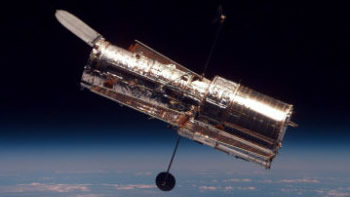Reuters
Shuttle blasts off to upgrade space station
By Reuters staff, November 15, 2008

The space shuttle Endeavour soared off its seaside launch pad on Friday on a mission to upgrade the International Space Station for an expanded six-person crew. The shuttle's twin booster rockets ignited at 1955 EST (0055 GMT on Saturday), catapulting the 2 million-kg ship with a blinding light into the clear, moonlit sky at the Kennedy Space Center in Florida.
"It's our turn to take home improvement to a new level," shuttle commander Chris Ferguson radioed to flight controllers minutes before launch. The launch countdown went smoothly until 15 minutes before lift-off, when engineers noticed that a door on the launch pad alongside the shuttle was not properly fastened. But managers determined it would not be an issue and cleared the ship for flight. It was NASA's first launch in nearly six months and the 124th in shuttle programme history.

•
Kennedy Space Center • NASA:
KSC Webcams
Just nine more launches remain before NASA is scheduled to mothball the shuttles so it can develop safer and less expensive spaceships that will return astronauts to the Moon. NASA must first complete construction of the $100 billion space station, a project of 16 partner countries. The shuttle Endeavour's flight is intended to outfit the station for six full-time residents. It has been operating with half that number since assembly began a decade ago.
The shuttle carries two new sleeping compartments and a water recycling system so station crew members can purify urine and other waste water for drinking. "We did blind taste tests of the water," said NASA's Bob Bagdigian, the system's lead engineer. "Nobody had any strong objections. Other than a faint taste of iodine, it is just as refreshing as any other kind of water."
Endeavour also carries the station's first refrigerator, new exercise gear, and perhaps most important for a growing crew - a second toilet. "With six people, you really do need to have a two-bathroom house. It's a lot more convenient and a lot more efficient," said Endeavour astronaut Sandra Magnus, who will take over as a space station flight engineer from Greg Chamitoff.

»
Karen Nyberg in Space »
Photos /
2 /
3
- Mission Specialist Dr. Karen Nyberg displays Longhorn Pride in orange socks while working aboard the Space Shuttle Discovery.
Chamitoff has been aboard the outpost since the last shuttle flight in June. Reusing water will become essential once NASA retires its space shuttles, which produce water as a byproduct of their electrical systems. Rather than dumping the water overboard, NASA has been transferring it to the space station.
But the shuttle's days are numbered. The nine remaining flights will include a final servicing call to the
Hubble Space Telescope. NASA is preparing to end the programme in 2010, after which Russian
Soyuz spacecraft will be the only way to ferry crew to the space station. "We can't be delivering water all the time for six crew," said space station flight director Ron Spencer. "Recycling is a must." Besides upgrading the space station's interior, the Endeavour crew will begin a marathon job to repair the station's solar power system.
A huge rotary joint that points solar power panels at the Sun is filled with metal shavings and must be cleaned up and greased. Four spacewalks are scheduled to tackle the problem, with as many as six more slated for future missions. In addition to Ferguson and Magnus, the crew includes pilot Eric Boe, spacewalkers Heidemarie Stefanyshyn-Piper, Stephen Bowen and Robert "Shane" Kimbrough and astronaut Donald Pettit, a former space station flight engineer. Endeavour is due back at the Kennedy Space Center on 29 November to close out the fourth and final mission of the year. (
More...)
New Scientist:
Purified urine to be astronauts' drinking water -
Space shuttle Topic Guide -
NASA: US should stick to Moon plan (
more)
____

•
Aerial view of the Launch Complex at NASA’s Kennedy Space Center shows space shuttles on both pads •
Web Photos •
Space Photos..
____
Related Articles:

»
NASA TV live
• NASA:
Space Shuttle Gallery - Photo, Audio, Video
• NASA:
NASA Shuttle Carries Camera To Help Farmers
• NASA:
Shuttle Endeavour Launches On Home Improvement Mission
 Graphics - The detection of an extreme "cold spot"
Graphics - The detection of an extreme "cold spot" Graphics - The detection of an extreme "cold spot"
Graphics - The detection of an extreme "cold spot"













 »
»  »
»  »
»  »
»  •
•  » BBC:
» BBC: 


 •
•  »
» 
 »
» 
 » Space.com:
» Space.com: 


 Commander
Commander  Pilot
Pilot  Pilot Eric Boe
Pilot Eric Boe 

 Astronaut
Astronaut  Heidemarie S.-Piper
Heidemarie S.-Piper  Astronaut
Astronaut 
 Mission specialists
Mission specialists 


 »
»  »
»  »
»